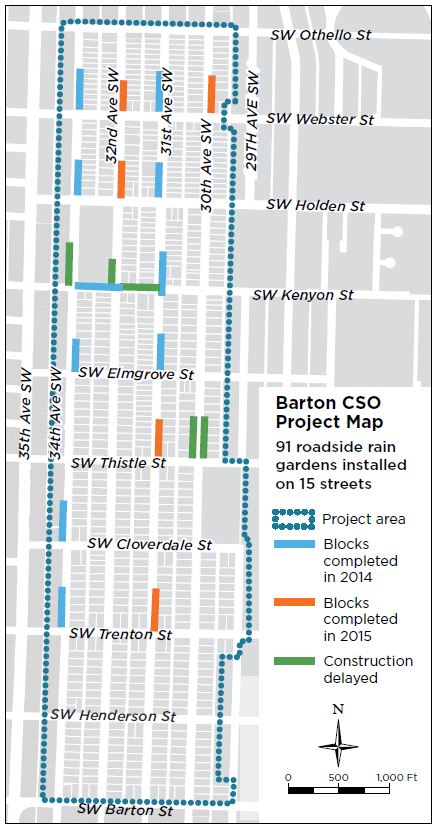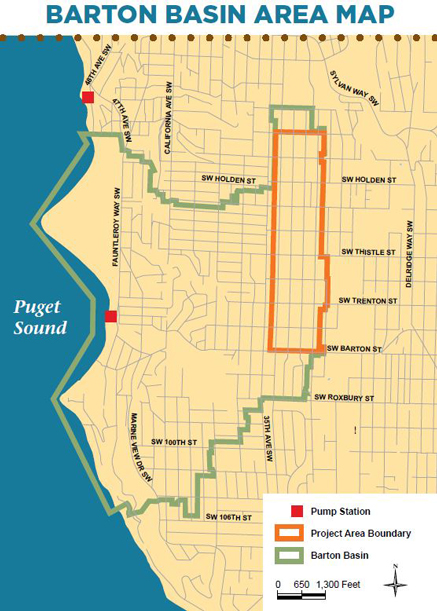Barton roadside rain gardens
Learn about the Barton roadside rain gardens, a green infrastructure project to control combined sewer overflows in West Seattle.
The Barton roadside rain gardens, part of the Barton combined sewer overflow (CSO) project, consist of 91 bioretention swales (a type of green stormwater infrastructure) located in planter strips between the curb and sidewalk on 15 blocks in the Sunrise Heights and Westwood neighborhoods in West Seattle. Bioretention swales are carefully designed landscaped depressions that have amended soil to capture and filter rainwater where it falls. When it rains, stormwater filters through the rain gardens to a drain pipe, which takes the water to a deep well for slow infiltration underground.
The Barton rain gardens are part of our commitment to keep stormwater out of the sewer system to reduce CSOs of raw sewage and untreated stormwater into Puget Sound during periods of heavy rain. Learn more about how King County is Protecting Our Waters.
Roadside rain garden maintenance
King County is responsible for regular maintenance of the roadside rain gardens year-round.
You can expect to see crews on-site at least monthly performing regular maintenance. Expect more frequent visits before and after large storms and during the summer growing season.
Here is what our crews will be doing:
- Monitoring plant health
- Removing weeds
- Monitoring drainage
- Removing debris and trash
- Clearing curb inlets and gutters
- Caring for the pipes and deep wells
- Gathering ongoing information on the performance of roadside rain gardens
FAQ


In the older parts of Seattle (including Sunrise Heights and Westwood), the wastewater (sanitary sewage) and stormwater pipes flow into a combined sewer. Combined Sewer Overflows (CSOs) are discharges of untreated sewage and stormwater released directly into marine waters, lakes and rivers during heavy rainfall, when the sewers have reached their capacity. Although the sewage in CSOs is greatly diluted by stormwater, CSOs may be harmful to public health and aquatic life because they carry chemicals and disease-causing pathogens.
Learn more about CSOs.
The Barton combined sewer basin is approximately 1,111 acres. When there is a combined sewer overflow event for Barton, the outfall of the untreated sewage and storm water into Puget Sound occurs near the Barton Street pump station located next to the Fauntleroy Ferry Terminal. Detailed basin maps are included in the March 2012 community meeting presentation.
The system is being designed to handle the water that falls within the project area in order to provide CSO control in the Barton basin. If the bioretention system gets overwhelmed (for example, during an extremely large storm or a series of back to back storms), the excess water will flow into the gutter to a drainage structure in the street that then discharges into the combined sewer system.
King County is responsible for maintenance of the bioretention swales, including watering, weeding, and general upkeep to ensure the proper operation of the bioretention system for CSO control. Costs for maintenance will be paid for by King County as part of the Protecting Our Waters (CSO Control) program.
Because the bioretention swales capture road runoff, they are not an appropriate location for growing vegetables for consumption. Specific plants play an important role in the function of the bioretention swales and it is important that the swales operate as designed.
No. The project is designed to covey stormwater deep and away from basements. Seepage through concrete basement walls and floors can be the result of a number of factors including a lack of building perimeter foundation footing drains, roof downspouts that are not directed away from the building, and perched subsurface groundwater. The perched subsurface groundwater occurs in areas where surface water has infiltrated to a given depth before hitting a layer of glacial till which has relatively low permeability. The project team has conducted extensive geotechnical studies to review the existing soil layers of Vashon Recessional Outwash, Glacial Till and Vashon Advance Outwash. See slides 17 and 19 in the presentation from the February 8, 2012 public meeting for a sample soil cross section. The swales will have an underdrain to intercept and collect the storm water and convey it to a well which then discharges runoff into the deeper Vashon Advance Outwash soils that are located below the low permeability Glacial Till. Since the storm water will be conveyed beneath the Glacial Till this will not add to current drainage problems residents may have.
The swales will be designed to capture street runoff and surface runoff from housing lots. King County will not be going onto private property to disconnect downspouts from houses.
Starting in the first quarter of 2013, residents of the Barton CSO basin are eligible for the RainWise program. The RainWise program provides rebates that cover up to 100 percent of the cost to install cisterns and rain gardens on private properties. For more information, visit: www.rainwise.seattle.gov.
The Stewardship Partners program also provides support to install rain barrels and rain gardens.
During storms, the bioretention swales are designed to temporarily pond, infiltrate and drain within 24 hours of a storm. It should be noted that temporary ponding will not occur for every storm event. However, if there are several back-to-back storms, there may be some ponding water for longer than the 24 hours but will drain down within 24 hours after the rain has stopped. There will be an underdrain pipe in the bioretention swales to collect the filtered water, convey it through the Glacial Till soils and discharge it into the deeper soils that are suitable for infiltrating stormwater.
Mosquitoes take 10-14 days to breed and hatch in shallow stagnant standing water, and the bioretention swales will be designed to drain within 24 hours. Mosquitoes also need stagnant water (such as found in bird baths, old tires, dog water bowls, etc.), and water in the swales will be flowing vertically through the soil into the underdrain or overflow back into the gutter at a curb cut. If you would like more information on mosquitoes and prevention, please see the Public Health - Seattle & King County website.
Bioretention swales are designed with safety in mind – such as considering temporary maximum ponding depth during a rain event, depth of shallow depression and places to safely cross the swales. The bioretention swales will typically drain out within 24 hours following a storm event.
King County is responsible for maintaining the bioretention swales; refer to the operations and maintenance plan . As part of the operations and maintenance approach, King County crews will maintain/check the bioretention swales including trash removal. Some homeowners may want to remove trash more often; as with all planting strips across the city, homeowners are encouraged to remove trash from the right-of-way.
Nuisance animals typically found within the urban environment, such as, raccoons, rats and possums are attracted when there is a food source, such as unsealed household waste containers. The landscaping within the bioretention swales will not be a preferable food source or habitat for the nuisance animals.
Bioretention swales will be located at least 300 feet away from steep slopes and 500 feet from known landslide areas in accordance with City requirements. Detailed geotechnical studies evaluated slope stability resulting from the infiltration of the storm water and determined what was required for design. See the February 8, 2012 presentation for more information about the geotechnical testing.
Nationally and locally, no municipality or agency has reported increased soil contamination from implementation of natural drainage systems in the public right-of-way when they are installed and maintained properly. Monitoring shows that pollutants degrade naturally over time as part of this process. There will be several bioretention swales along a street thus allowing the storm water to be dispersed and treated over a large area; thus reducing point load concentrations. King County has developed an operations and maintenance plan to ensure the water quality function of the bioretention soil and plants over the long term.

 Translate
Translate